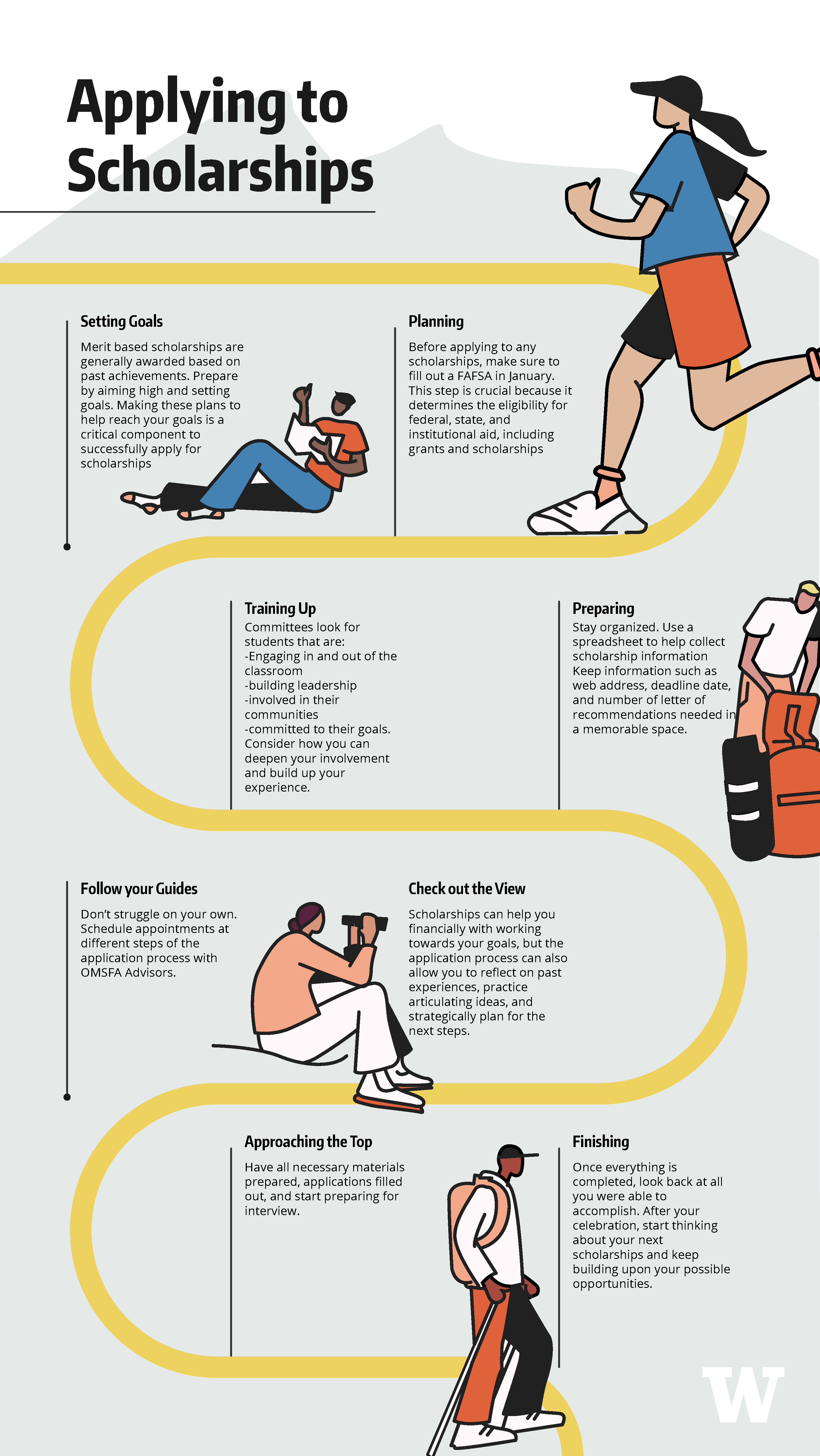How To Apply For Scholarships In The USA
Securing a scholarship in the USA can feel like searching for a needle in a haystack, but did you know over $6 billion in scholarships are awarded annually? That’s a substantial pool of resources waiting to be tapped into. It starts with thoroughly researching available scholarships that align with your academic achievements and interests.
Dive into databases and scholarship search engines such as Fastweb and scholarships.com. Pay special attention to scholarships offered by universities directly, as they often have less competition. Crafting a standout application with a compelling personal statement and strong letters of recommendation is crucial.
- Research available scholarships through databases like Fastweb and scholarships.com.
- Identify eligibility criteria for each scholarship.
- Prepare a standout application with all required documents, including personal statements and recommendation letters.
- Submit your applications well before the deadlines.
- Follow up to ensure receipt and completeness of your applications.

How to apply for scholarships in the USA
Applying for scholarships in the USA can help you save a lot on your educational costs. Start by conducting thorough research on the different types of scholarships available. Use scholarship search engines like Fastweb and scholarships.com. Make a list of all the scholarships that fit your qualifications. This will help you stay organized and focused.
Next, check the eligibility criteria for each scholarship. Some might be based on academic achievements, while others could be for athletic skills or community service. Make sure you meet all the requirements before applying. This will save you time and increase your chances of success. Double-check the deadlines and mark them on your calendar.
Once you’ve shortlisted the scholarships, the next step is to prepare your applications. Write a compelling personal statement that highlights your strengths and achievements. Request strong letters of recommendation from your teachers or mentors. Make sure to proofread your application to avoid any mistakes. A well-prepared application increases your chances of getting awarded.
Submitting your application early can give you an edge. Many scholarships review applications on a rolling basis, so the sooner you apply, the better. Follow up with the scholarship committees to confirm they received your application. Keep a copy of all the documents you submitted. This way, you can refer back in case there are any issues.
Step 1: Conducting a Thorough Research
Conducting thorough research is the cornerstone of applying for scholarships in the USA. Start by exploring various scholarship websites and databases. Use tools like Fastweb, scholarships.com, and the College Board’s scholarship search. These platforms offer extensive lists of scholarships tailored to different needs and qualifications. Keep a record of the scholarships you find suitable.
While searching, pay attention to different types of scholarships. Some are merit-based, while others may focus on specific talents or community involvement. It’s important to recognize which category you fall into. Create a spreadsheet to track the scholarships you’re eligible for. This way, you can easily compare and manage application deadlines.
Engage in forums and social media groups dedicated to scholarship opportunities. These communities can offer valuable tips and firsthand experiences. Sometimes, smaller scholarships from local organizations or businesses can be found through these channels. Joining such groups can make your search more comprehensive. Plus, it’s a great way to connect with others who are also applying.
Lastly, visit the financial aid pages of colleges and universities you’re interested in. Many institutions offer their own scholarships, which may have less competition. Keep an eye on requirements unique to each scholarship. Knowing these peculiarities boosts your chances of meeting them successfully. Early and detailed research sets a strong foundation for your scholarship application journey.
Step 2: Identifying your Eligibility Criteria
Identifying your eligibility criteria is essential in applying for scholarships in the USA. Different scholarships have varied requirements you must meet to qualify. These can range from academic achievements to community service or athletic prowess. Carefully read the details provided for each scholarship. This helps you understand if you fit the eligibility mold.
List your strengths, hobbies, and accomplishments. This will help you align them with the criteria of specific scholarships. For instance, if you excel in sports or have a strong academic record, look for scholarships that recognize these attributes. Some scholarships may also focus on specific fields of study or career goals. Knowing what you excel at will narrow down your options effectively.
Some scholarships are targeted towards certain groups. These may include scholarships for minorities, women, or students from specific regions. Also, consider scholarships based on financial need. Identifying these specific categories can increase your chances of finding suitable opportunities. Don’t hesitate to apply for multiple scholarships.
Keep a checklist of each scholarship’s requirements. This includes GPA requirements, essays, and letters of recommendation. Using a table can help you keep track of these criteria:
| Scholarship Name | Eligibility Criteria | Deadline |
|---|---|---|
| ABC Scholarship | Minimum GPA of 3.5, essay required | June 15 |
| XYZ Scholarship | Community service, letter of recommendation | July 1 |
This organized approach ensures you don’t miss any important details. Meeting all eligibility criteria can significantly boost your chances of securing scholarships.
Step 3: Preparing a Stand-Out Application
Preparing a stand-out application is key to securing a scholarship. Start by gathering all the necessary documents. This typically includes test scores, transcripts, and a personal statement. Organize these documents neatly to reflect a professional image. Double-check that you have all the required materials before submission.
Next, focus on writing a compelling personal statement. Your personal statement should highlight your achievements, goals, and why you deserve the scholarship. Be honest and authentic in your writing. It’s also important to tailor your statement for each scholarship. This demonstrates your genuine interest and dedication.
High-quality letters of recommendation can significantly impact your application. Approach teachers, mentors, or employers who know you well and can vouch for your abilities. Provide them with ample time to write a thoughtful letter. Share your resume or a brief overview of your accomplishments to help them write a strong recommendation. Ensure their contact information is up-to-date.
- Proofread Your Application: Spelling and grammar errors can make a bad impression.
- Follow Instructions: Adhere to word limits and other specific guidelines.
- Be Creative: Show your unique personality and stand out from the crowd.
Submitting your application early can give you an edge. Many scholarships review applications on a rolling basis. Early submission shows you are diligent and well-prepared. Plus, it gives you time to correct any last-minute errors. Always save a copy of your application for future reference.
Use tables to keep track of your application progress:
| Task | Status | Deadline |
|---|---|---|
| Gather Documents | Complete | May 1 |
| Write Personal Statement | In Progress | May 15 |
| Request Letters of Recommendation | Pending | April 25 |
A well-prepared, thorough application increases your chances of receiving a scholarship. Make sure to follow all the steps and guidelines carefully.
Step 4: Writing a Compelling Personal Statement
Writing a compelling personal statement is a crucial step in your scholarship application. Begin by brainstorming your key achievements, experiences, and goals. Think about what makes you unique. This will help you create a strong introduction that captures the reader’s attention. Your opening should make them want to learn more about you.
Be sure to tell a story in your personal statement. Describe a specific event or challenge that shaped your aspirations. How did you overcome it? What lessons did you learn? Use vivid details to make your story memorable. This can make your application stand out among many others.
Focus on how the scholarship will help you achieve your goals. Explain why this particular scholarship is important to you. Discuss the impact it will have on your education and future career. This demonstrates your motivation and ambition. Show that you have a clear plan and direction.
Keep it concise and to the point. Follow any given word or character limits strictly. Break your statement into clear paragraphs. This ensures readability and helps maintain the reader’s interest. Proofread your statement multiple times to catch any errors.
Ask for feedback from teachers or mentors. They can provide valuable insights and suggestions for improvement. Incorporate their advice to strengthen your statement. Make sure every sentence adds value and serves a purpose. A well-crafted personal statement can significantly boost your scholarship chances.
Step 5: Securing Strong Letters of Recommendation
Securing strong letters of recommendation is critical for your scholarship application. Start by choosing the right people to write them. Ideally, these should be teachers, mentors, or employers who know you well. They should be able to speak to your strengths, achievements, and character. This ensures that their recommendation carries weight.
Approach your recommenders early to give them plenty of time. Explain why you need the letter and provide context about the scholarship. Share your resume, achievements, and any specific points you’d like them to highlight. This will help them write a more comprehensive and impactful letter. Don’t forget to thank them for their help.
Remind your recommenders of the deadlines as they draw near. Ensure they know where and how to send the letters. Sometimes, scholarships have specific submission guidelines. Provide these instructions clearly to avoid any confusion. A gentle reminder can help ensure everything is submitted on time.
- Choose Recommenders Wisely: Select people who know you well.
- Provide Context: Share details about the scholarship and your achievements.
- Set Deadlines: Give ample time and reminders to your recommenders.
Consider asking for a copy of the letter for your records. This can be helpful if you need to apply for multiple scholarships. Keep track of who you’ve asked and when they’ve submitted the letters. Using a table can help you manage this process:
| Recommender | Status | Submission Date |
|---|---|---|
| Mr. Smith | Pending | April 10 |
| Ms. Johnson | Submitted | March 20 |
Strong letters of recommendation can make a big difference in your scholarship application. Make sure to choose the right people and give them the tools they need to write a great letter. This extra effort increases your chances of success.
Maintaining Scholarship Once Awarded
Once you’ve been awarded a scholarship, maintaining it is crucial. Most scholarships come with specific requirements you must meet to keep receiving the funds. These often include maintaining a certain GPA, being enrolled full-time, or completing community service hours. Make sure you’re fully aware of these conditions. Keeping track of them helps you stay on course.
Create a schedule to help manage your commitments effectively. Good time management can make it easier to balance your academic and extracurricular responsibilities. Use a planner or digital calendar to mark important dates and deadlines. This helps prevent last-minute stress and ensures you meet all criteria. Consistency is key in maintaining your scholarship.
- Maintain Required GPA: Regularly check your grades and seek help if needed.
- Participate in Required Activities: Take part in community service or clubs as required.
- Meet Deadlines: Submit any necessary reports or documents on time.
Stay in communication with the scholarship provider. They may have ongoing requirements like periodic progress reports or meetings. Reach out if you’re facing difficulties meeting the requirements; they might offer flexibility or advice. Staying proactive about communication shows responsibility and commitment.
If your circumstances change, such as needing to drop a class, inform the scholarship provider immediately. Transparency can sometimes lead to accommodations that will help you maintain the scholarship benefits. Keep copies of all correspondence related to your scholarship for future reference. A well-maintained record can be handy for resolving any issues that arise later.
| Requirement | Status | Deadline/Notes |
|---|---|---|
| GPA Maintenance | Current GPA: 3.8 | Ongoing |
| Community Service Hours | Completed: 20 hours | Total Required: 30 hours by June |
Staying organized and proactive helps you retain your much-needed educational funding.
Common Mistakes to Avoid When Applying for Scholarships
Applying for scholarships can be competitive, so it’s essential to avoid common mistakes. One major mistake is submitting applications after the deadline. Late submissions are usually disqualified, no matter how strong your application is. To avoid this, keep a calendar of important dates. Set reminders a week before each deadline.
Another common mistake is not following instructions. Each scholarship has specific guidelines you need to follow. Whether it’s a word limit for essays or the format for documents, missing these details can hurt your chances. Read and reread the instructions carefully. Double-check your application before you submit it.
Generic applications can also diminish your chances of success. Writing a one-size-fits-all essay is not a good idea. Tailor each application to the specific scholarship by addressing how you meet their criteria. Mention any particular requirements they have in your application. Personalization shows you’re genuinely interested.
- Missing Deadlines: Keep a calendar and set reminders.
- Ignoring Instructions: Follow guidelines closely.
- Generic Applications: Personalize each submission.
Not proofreading your application can result in avoidable errors. Spelling and grammar mistakes can make you appear careless. Always take the time to review your application thoroughly. Consider asking a teacher or mentor to proofread it for you. A polished application can make a better impression.
Failing to secure strong letters of recommendation is another common pitfall. Make sure to choose recommenders who know you well and can write positively about you. Give them plenty of time and all the information they need. Strong recommendations can significantly enhance your application. Avoid these common mistakes to improve your chances of getting a scholarship.
Importance of Making Early Applications
Making early applications can significantly boost your chances of landing a scholarship. Many scholarships operate on a rolling basis, meaning they review applications as they come in. If you apply early, your application might be one of the first they read. This can give you a better shot at standing out. Also, some scholarships run out of funds quickly, so being early can be a huge advantage.
Early applications also show that you are organized and motivated. This can impress scholarship committees. They often look for students who demonstrate initiative and responsibility. Applying ahead of time reflects these qualities. It can set a positive tone for the rest of your application.
Another benefit of applying early is that it gives you plenty of time to handle any unexpected issues. For instance, you may need more time to gather documents or get a letter of recommendation. An early start means you have the flexibility to manage these challenges. This reduces stress and helps ensure a complete application.
Applying early also allows for more thorough proofreading and feedback. You can ask teachers or mentors to review your application and provide tips for improvement. This can make your application stronger. Use tables to keep track of early application details:
| Scholarship | Application Period | Early Deadline |
|---|---|---|
| ABC Scholars | Jan 1 – Mar 31 | Feb 15 |
| Future Leaders | Feb 1 – Apr 30 | Mar 10 |
Lastly, early applications can sometimes lead to early decisions. Knowing whether you’ve won a scholarship can influence your other plans. It can help you make informed decisions about which schools to attend or what other scholarships to apply for. In this way, early applications offer both immediate and long-term benefits.
Real-Life Examples of Successful Scholarship Applications
Real-life examples can inspire and guide you in your scholarship journey. Take Jane, for instance. Jane applied to multiple scholarships and was awarded several. She focused on her unique experiences, including her volunteer work and leadership roles. Her well-rounded profile impressed the scholarship committee.
Another example is Mark, who won a full-ride scholarship to his dream college. Mark’s application stood out because he wrote a heartfelt essay about overcoming adversity. He shared his journey of balancing school and helping his family. His genuine story resonated with the committee, showing the power of personal experiences.
Sara is also a great example of success. She concentrated on academic excellence, earning high grades. But she didn’t stop there. She also demonstrated her passion for environmental science through various projects and internships. Her application highlighted her dedication and future goals, making her a top candidate.
- Focus on Unique Experiences: Highlight what makes you different.
- Be Genuine: Share your true story and challenges.
- Demonstrate Passion: Show your enthusiasm for your field of interest.
A table tracking their accomplishments could look like this:
| Student | Main Focus | Key Accomplishments |
|---|---|---|
| Jane | Community Service | Volunteer Work, Leadership Roles |
| Mark | Personal Story | Overcoming Adversity, Balancing School and Family |
| Sara | Academic Excellence | High Grades, Environmental Projects |
These examples show that successful applications often share certain traits. They focus on unique experiences, genuine stories, and demonstrated passion. Use these elements in your application to increase your chances of success.
Frequently Asked Questions
Applying for scholarships in the USA can be challenging but rewarding. Here are some common questions to help you navigate the process effectively.
1. What common documents are needed for scholarship applications?
Common documents include your academic transcripts, test scores, and a personal statement. You may also need letters of recommendation from teachers or mentors.
Make sure to double-check each scholarship’s requirements. Some might ask for additional materials like proof of financial need or specific essays.
2. How can I identify scholarships that are right for me?
Start by listing your strengths, achievements, and interests. Use scholarship search engines like Fastweb to find opportunities matching your profile.
You can also explore the financial aid pages of universities. Often, they offer scholarships tailored to students attending their school.
3. Are there scholarships specifically for international students?
Yes, many US institutions provide scholarships aimed at international students. These can range from partial tuition waivers to full-ride scholarships.
Universities often highlight these opportunities on their websites. External organizations and government programs may also offer financial support options.
4. How important is the personal statement in a scholarship application?
The personal statement is crucial because it allows you to showcase your personality and achievements. It can set you apart from other applicants with similar qualifications.
A strong personal statement highlights your unique experiences and future goals. Tailor each statement to the specific scholarship you’re applying for.
5. When should I start applying for scholarships?
You should begin your search at least one year before you plan to enroll in college. This gives ample time to meet different deadlines and prepare strong applications.
Many scholarships have early deadlines, so planning ahead ensures you won’t miss out on opportunities. It’s always better to start early than rush through applications last minute.
Conclusion
Applying for scholarships in the USA can greatly reduce your financial burden. By researching thoroughly, identifying your eligibility, and preparing strong applications, you enhance your chances significantly. Start early and follow each step diligently, tailoring your efforts to the specific requirements of each scholarship.
Remember, each component of your application, from personal statements to recommendation letters, plays a vital role. Maintain organization and stay proactive in meeting deadlines and requirements. Your dedication and effort can open doors to a brighter educational future.







